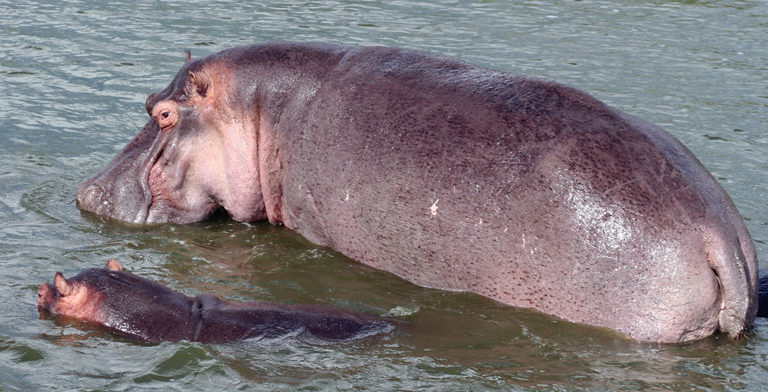
- Every two weeks, Mongabay brings you a new episode of Candid Animal Cam, our show featuring animals caught on camera traps around the world and hosted by Romi Castagnino, our writer and conservation scientist.
Camera traps bring you closer to the secretive natural world and are an important conservation tool to study wildlife. This week we are meeting the common hippo.
Common hippos (Hippopotamus amphibius) live in sub-Saharan Africa and are the third-largest living land mammal, after elephants and white rhinos, weighing as much as 3 tons and about the size of an average car. Despite their bulky appearance, they have adaptations to their semi-aquatic environments allowing them to move swiftly on both water and land. On land, they can move at speeds up to 30 km per hour and in water, their webbed feet provide powerful propulsion. Hippos are the only mammals in the world to produce amphibious calls. They can communicate sound simultaneously in air and underwater like frogs do.

Hippos are a very social species, living in groups of about 20 to 30 individuals, but some groups may include up to 200 members. Hippos have a unique way of marking their territories. They poop and use their flat, paddle-like tail to spread it in the water. When needed, male hippos will fiercely defend their territories by wrestling intruders and clashing and locking their enlarged teeth with each other.

Hippos play an essential role in the African ecosystem. First, as hippos poop in the water, they provide nutrients to aquatic life. And second, as they enter and exit their water pools at the same spot, these hippo paths generate habitats for smaller organisms and create routes through which the rainwater flows during the wet season. And when these paths are flooded, lagoons emerge where small fish retreat during droughts.

Besides humans, adult hippos have no known predators, although babies can fall prey to lions, hyenas and crocodiles. The IUCN classifies the species as vulnerable. Its main threats are unregulated poaching, hunting and habitat loss. Because hippos rely on freshwater bodies, they are susceptible to drought, agricultural and industrial development. Watch the video to learn more about this species!
Special thanks to Pearson McGovern for sharing his footage with us. Pearson is a research biologist for the African Chelonian Institute (ACI), a nonprofit organization focused on conserving Africa’s turtles and tortoises and their habitats through research, education, and grassroots collaboration. With efforts throughout West Africa, ACI is doing its part to ensure that this threatened group of animals has a fighting chance in a rapidly changing world. ACI is a part of the African Aquatic Conservation Fund (AACF), which has a broad focus on Africa’s aquatic ecosystems and the threatened wildlife that call these ecosystems home. For more on both ACI’s and AACF’s work, you can follow them at either africanchelonian.org and Africanaquaticconservation.org, respectively, or on both Facebook and Instagram. To follow Pearson in the field, follow @pearsmcg on Instagram.
Romi Castagnino is Mongabay’s bilingual writer. Find her on Twitter and Instagram: @romi_castagnino
Banner image by Rhett A. Butler.
The secret lives of common hippos | Candid Animal Cam
Source: Trends News

0 Comments